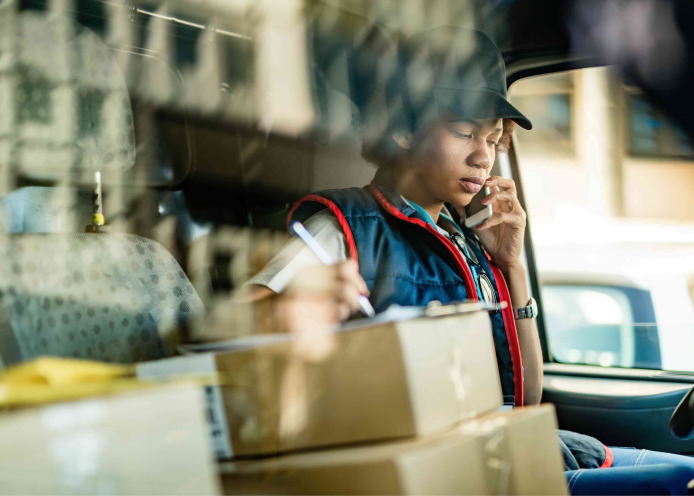Unlocking Holiday Shipping Strategies: Key Insights for eCommerce Success
As we edge closer to the bustling holiday season, the spotlight intensifies on the crucial role of shipping strategies within the eCommerce sector. In this article, inspired by the latest episode of The Checkout Point podcast, we delve into the intricate dance between shipping giants like UPS and USPS and the eCommerce businesses that depend on them. With the holiday rush looming, understanding the balance of surcharges, customer demands, and efficient delivery services is more vital than ever for eCommerce marketers, managers, and founders striving to stay on top of the market.

Navigating the Surcharge Maze
The holiday season brings joy and a significant uptick in shipping volumes. Companies like UPS and USPS are at the forefront, managing an overwhelming influx of packages worldwide. We explore how these shipping behemoths adjust their strategies to handle the surge and what this means for businesses relying on their services. It’s not just about staying afloat during the holiday rush but thriving by leveraging the insights on operational adjustments and surcharge integrations.
The Big Picture: Beyond Package Delivery
While the primary focus might seem centered on shipping logistics, the implications run deeper, influencing both consumer satisfaction and global eCommerce dynamics. Staying informed on these shifts is crucial for any business looking to optimize their holiday shipping strategies and enhance overall customer experience.
Whether you’re involved in logistics, management, or strategy in the eCommerce arena, this exploration into holiday shipping strategies is steeped in crucial insights that could shape your business decisions and operational directives in the upcoming holiday season. Read on to discover actionable strategies and deepen your understanding of the eCommerce landscape as dictated by shipping leaders.
Understanding Holiday Shipping Strategies Amidst Rising Surcharges
Welcome back to our exploration of the dynamic world of shipping and supply chain adjustments. Today, we’re focusing on a particularly critical aspect of shipping logistics—holiday shipping strategies. As the festive season approaches, the game of managing timely package deliveries while balancing surcharge fees is more intricate than ever.
Let’s consider UPS’s recent decision to hike surcharge fees during the peak holiday season. This isn’t merely an arbitrary price increase; it’s a strategic move designed to manage shipping volumes during the busiest time of the year. Imagine millions of packages, each representing a holiday wish, traversing the globe. Facing a shorter shopping window, UPS argues these surcharges are crucial for maintaining efficiency and ensuring all these wishes land under the twinkling lights of holiday decor, precisely on time.

Shaping Consumer and Business Shipping Practices
Increased surcharges are not just logistical necessities; they also serve as subtle nudges to businesses, influencing their shipping habits. With the cost increase, both big retailers and small shop owners need to strategize their shipping timelines more meticulously. This could mean sending out batches of shipments earlier than usual or breaking them into smaller, more manageable volumes. In essence, it’s about smoothing out the end-of-year shipping tsunami into more consistent, predictably spaced waves.
Adjustments in Packaging: A Nod to Sustainability and Economics
In an intimate shift within the postal sphere, USPS’s decision to phase out one of their box options might seem minor but is significantly reflective of broader trends. Encouraging the use of tubes over traditional boxes suggests a move towards more sustainable and economically viable packing solutions. This subtle change is a nod to evolving market demands and environmental considerations, part and parcel of the larger narrative of adapting shipping practices to modern challenges.
Broader Implications of Shipping Strategy Adjustments
These strategic adjustments extend beyond corporate boardrooms. They ripple out to impact small businesses relying on affordable shipping options, consumers planning their holiday shopping, and workers within these industries bracing for a hectic season. Each decision made by big players like UPS and USPS doesn’t only recalibrate their operations but also affects the entire e-commerce ecosystem.
Next time you find yourself clicking that “order” button or preparing to ship a holiday package, consider the complex tapestry of decisions and adjustments that make the journey of each item possible. From surcharge strategies detailed in UPS’s defense of its holiday strategy to the subtler shifts in packaging preferences, every change is part of a larger narrative of adaptation aimed at delivering not just parcels, but also joy and convenience in the holiday hustle.
As we wrap up today’s discussion, remember that every shipped item and every logistical adjustment is a stitch in the fabric of a much broader story—one punctuated by resilience, strategic foresight, and the persistent pursuit to deliver satisfaction and cheer during the holiday season. Tune in next time as we continue to unravel these stories that connect us all more deeply with the bustling world of e-commerce.
Understanding Amazon’s Strategic Shifts: What It Means for Small Businesses and Global Trade
Welcome back to our ongoing exploration of the global retail environment and its influential giants. Today, we delve into a topic that touches not only the ubiquitous influence of Amazon but also the broader intricacies of global supply chains and dynamics affecting small businesses. We’re focusing on Amazon’s recent strategic changes: the reduction in the claims window for lost inventory and the company’s initiative for direct-from-China shipping.

Amazon’s Slimmed-Down Claims Window: A Tightrope for Small Businesses
Imagine starting your day as a small business owner selling goods on Amazon. The sun is shining, you’re sipping your morning coffee, and then you log in to your dashboard only to discover some of your inventory is missing. Previously, Amazon gave sellers a generous 9 months to report such losses. However, recent policies have slashed this period to a mere 30 days. This abrupt change forces businesses into a frenzy of inventory checks and quick decisions, significantly elevating the stress and stakes of logistics management.
This policy shift, purportedly aimed at enhancing efficiency and encouraging tighter logistics oversight, disproportionately impacts smaller vendors. These businesses already face numerous challenges, from capital limitations to smaller operational scales, making it harder to adapt to such rapid policy changes quickly.
Amazon’s Direct-from-China Shipping: Stirring the Pot of Global Controversy
Another strategic shift by Amazon that has sparked debate is its direct-from-China shipping initiative. This move is seen by many as a disruptive force to local markets, possibly tilting the scales unfairly in favor of imported goods. According to critics, highlighted in discussions and analyses, this could enable Amazon to undercut local businesses drastically by offering a stream of cheaper, accessible products directly from Chinese manufacturers.
The implications of such a direct shipping route are profound. Local manufacturers and businesses face a daunting wave of competition, potentially affecting everything from domestic trade dynamics to employment rates. Furthermore, this strategy raises questions about the ethical dimensions of labor practices and environmental impacts, both of which are hotly debated topics in global trade discussions.
Broader Impacts on Global Trade and Local Economies
These strategic moves by Amazon underscore the company’s ability to not only influence consumer preferences but also sculpt the structural foundation of global markets and local economies. For consumers, the allure of lower prices and broader selection is undeniable. However, the consequent challenges for local entrepreneurs and the looming concerns over trade equity and economic diversity invite a critical evaluation of these practices.
As these developments unfold, they beckon a closer look and possibly a recalibration of how we, as consumers and business stakeholders, navigate our roles. The changing dynamics instigated by such corporate strategies offer a moment to reflect on their far-reaching implications not just on a micro level but also globally.
In this light, corporate strategies like those of Amazon are not just about business efficiencies or market expansion. They represent pivotal elements that could redefine the landscape of global and local commerce, urging all involved parties to stay informed, stay critical, and, importantly, stay engaged.
Understanding these shifts helps us better navigate our choices and their ripple effects in the global market sphere. Let’s continue this conversation and examine how such significant moves by retail giants affect us all, from the small business owner to the everyday consumer and beyond.
AI’s Pivotal Role in Shaping Holiday Shopping Strategies
Welcome to our exploration of how Artificial Intelligence (AI) is revolutionizing ecommerce, particularly in the realm of holiday shipping strategies. As the festive season approaches, the intersection of AI and technology emerges as a key player in enhancing our online shopping experiences. Today, we delve into two major tech narratives that illustrate this transformation.

Google’s Stance on Cookies: A Balancing Act of Personalization and Privacy
Recently, Google announced a significant shift concerning third-party cookies in Chrome. Initially set to phase out by 2022, this decision has been postponed, sparking a wave of speculation. For those unaware, third-party cookies are small data pieces stored on our devices, primarily to track browsing activities. While this move means our shopping experiences can remain personalized during the holiday seasons, it also raises concerns about how our personal data is utilized.
This decision by Google underscores a crucial dilemma: the trade-off between enhanced personalization and consumer privacy. With cookies, retailers can tailor their holiday promotions and shipping options to individual preferences, potentially boosting sales. However, the lingering question of privacy remains a concern. How much is our desire for personalized shopping infringing on our right to privacy?
OpenAI’s SearchGPT: A New Frontier in Product Discovery
In an intriguing development, OpenAI has rolled out ‘SearchGPT’. This new AI-powered tool challenges traditional search engine dynamics, introducing a model that understands context and generates human-like text based on user queries. Unlike traditional keyword-based search engines, SearchGPT offers an advanced AI integration that could significantly alter how we discover and purchase products online during the holiday season.
The implications of SearchGPT for ecommerce are vast. As consumers look for quick and efficient ways to manage their holiday shopping, SearchGPT’s intuitive search capabilities could simplify product discovery, recommendation, and ultimately, choice. This could lead to quicker decisions, optimized shipping strategies, and enhanced customer satisfaction.
In conclusion, the advancements in AI are not just altering the retail landscape; they are reshaping how consumers engage with online shopping and holiday planning. As AI and technology continue to evolve, they bring forward both opportunities and challenges. The key for both consumers and marketers is to find a harmonious balance between leveraging AI for an improved shopping experience and maintaining ethical standards regarding data privacy.
As we continue to navigate these changes, staying informed and adaptable will be crucial. After all, understanding these dynamics today will equip us better for the smarter shopping landscapes of tomorrow.
Exploring the Evolving Terrain of Ecommerce M&A
As the landscape of ecommerce continuously reshapes itself, one of the most transformative forces at play are mergers and acquisitions (M&A). Far from being mere corporate jargon, M&A activities hold the power to radically alter the online shopping domain. According to insights from a recent coverage titled Ecommerce M&A Stabilizing, Advisor Says, the stabilizing trends in ecommerce M&A indicate significant shifts toward market maturity and operational rhythm.
This maturity does not signal a stagnation, but rather a promising horizon where businesses amalgamate to streamline logistics, enhance customer service, and broaden product availability. For consumers, this could translate to smoother, more reliable shopping experiences. Picture your favorite online storefronts merging, combining their strengths to form a more robust, comprehensive shopping hub. This is the potential landscape moulded by strategic ecommerce M&A.
The AI Revolution in Ecommerce
Parallel to the developments in M&A, Artificial Intelligence (AI) is revolutionizing ecommerce at a staggering pace. For Chief Information Officers (CIOs) today, AI is increasingly viewed not merely as a tool, but as an essential teammate within the retail ecosystem. According to Charts: How CIOs View AI, there is a burgeoning confidence in AI’s role in driving sales and enhancing customer interaction.
Envision entering a virtual store where the AI recognizes your preferences, predicts your concerns, and resolves them proactively, making every digital interaction personalized and efficient. This AI-driven personalization is leading the shift from traditional transactional relationships to deeper, anticipatory customer engagement models.

Conclusion: A New Era of Ecommerce Intelligence
Both the evolutions in Ecommerce M&A and AI implementation are pivotal in sculpting a future where technology transcends traditional shopping mechanisms to offer personalized, intuitive, and efficient consumer experiences. As shoppers, understanding these underlying strategies enhances our navigation through digital spaces, making us not just consumers, but well-informed participants in the digital marketplace.
The next time you navigate through an online store, remember the sophisticated strategies and technological advancements working silently to optimize your shopping experience. With ongoing innovations in AI and strategic M&A activities, the future of ecommerce promises to be as exciting as it is user-centric. Stay tuned, and always stay digital!
Unpacking the Impact of Legal Shifts in eCommerce
Welcome to a fresh perspective on the evolving eCommerce landscape, where the digital marketplace continuously intersects with the dynamic world of law and regulation. Today, we delve deep into two groundbreaking legal developments, each likely to leave a significant imprint on how we engage in online transactions.

Amazon Teams Up with the Better Business Bureau: A Legal Powerhouse
In an unexpected coalition, Amazon and the Better Business Bureau (BBB) have joined forces in a new lawsuit, highlighting their commitment to enhancing consumer trust and safety in online dealings. This legal maneuver is not merely about corporate muscle-flexing. Rather, it’s a focused attempt to curb fraudulent activities and deceptive practices that jeopardize consumer confidence. Such strategic alliances signal a transformative era in eCommerce, advocating for a secure marketplace where consumers can shop without hesitation.
Regulatory Reforms Across the Pond: The “Buy Now, Pay Later” Phenomenon
Meanwhile, over in Britain, significant changes are brewing concerning the regulation of “buy now, pay later” (BNPL) services, such as those offered by Klarna. These popular schemes have reshaped shopping behaviors, allowing consumers the flexibility to acquire goods immediately while deferring payment. According to recent reports from CNBC, the impending regulations aim to strike a delicate balance between fostering innovation and safeguarding consumers. With the potential to redefine consumer credit norms, especially among the youth, these reforms are poised to impact broad aspects of financial behavior and consumer rights.
The Broader Implications for eCommerce Participants
What do these legal adjustments signify for you as a consumer or an eCommerce marketer? They represent a steadfast dedication to fostering a fairer trading environment online. For younger consumers in particular, grasping these changes is critical. The evolving legal landscape offers more than convenience; it serves as a guide through the nuances of financial and consumer rights that will shape future eCommerce engagements.
In essence, whether it pertains to Amazon’s strategic partnerships or Britain’s regulatory approach to BNPL services, these initiatives underscore the continuous progression of eCommerce in meeting the complex needs of today’s digital consumers. By staying informed about these changes, we empower ourselves to make more informed, secure purchasing decisions.
As the digital marketplace grows, every transaction, every click, and every legislative reform plays a crucial role in sculpting the future of online shopping. Stay tuned as we continue to explore how these pivotal movements are redefining the rules of the digital game.
Wrapping Up the Latest in eCommerce
As we conclude our exploration of this week’s significant eCommerce developments, from innovative shipping strategies to AI’s evolving roles and Amazon’s strategic maneuvers, we must consider the implications of these shifts for the year’s busiest shopping period. The holiday season is fast approaching, and with it, the need for effective holiday shipping strategies becomes crucial. Be it UPS, USPS, or any other shipping giant, their movements are more than just logistics; they are about ensuring consumer delight and trust in the robustness of eCommerce platforms.

Reflecting on Strategic Innovations
The evolution we’re witnessing in Amazon’s policies and the broader AI implications across privacy and convenience are more than just news items; they signal a dynamic shift that demands keen attention from every eCommerce marketer, owner, and manager. Whether you’re rethinking your approach to third-party cookies in light of Google’s new policies or considering integrating more AI-driven tools in response to consumer demands, strategic innovation remains at the core.

What’s Next?
Considering the depths of discussions from today’s roundup, from mergers and acquisitions to international regulations, we’re not just observing changes; we’re standing at the precipice of a digital revolution in commerce. How will these changes impact your strategies? Are you prepared to adapt your holiday season plans to leverage these insights effectively? Here’s where your forward-thinking can turn news into action.
Engage with Us
What are your thoughts on these developments? Are you considering any specific holiday shipping strategies to boost your consumer satisfaction and retention? How do you plan to implement the AI advancements into your eCommerce ecosystem? We’re curious to know how these insights are shaping your strategies.
Feel free to share your thoughts and questions in the comments below. Let’s dive deeper into these discussions and help each other navigate the sprawling landscape of eCommerce. Remember to keep exploring, keep innovating, and tune in to the next episode of The Checkout Point for your weekly dose of eCommerce insights. Until then, happy strategizing!










